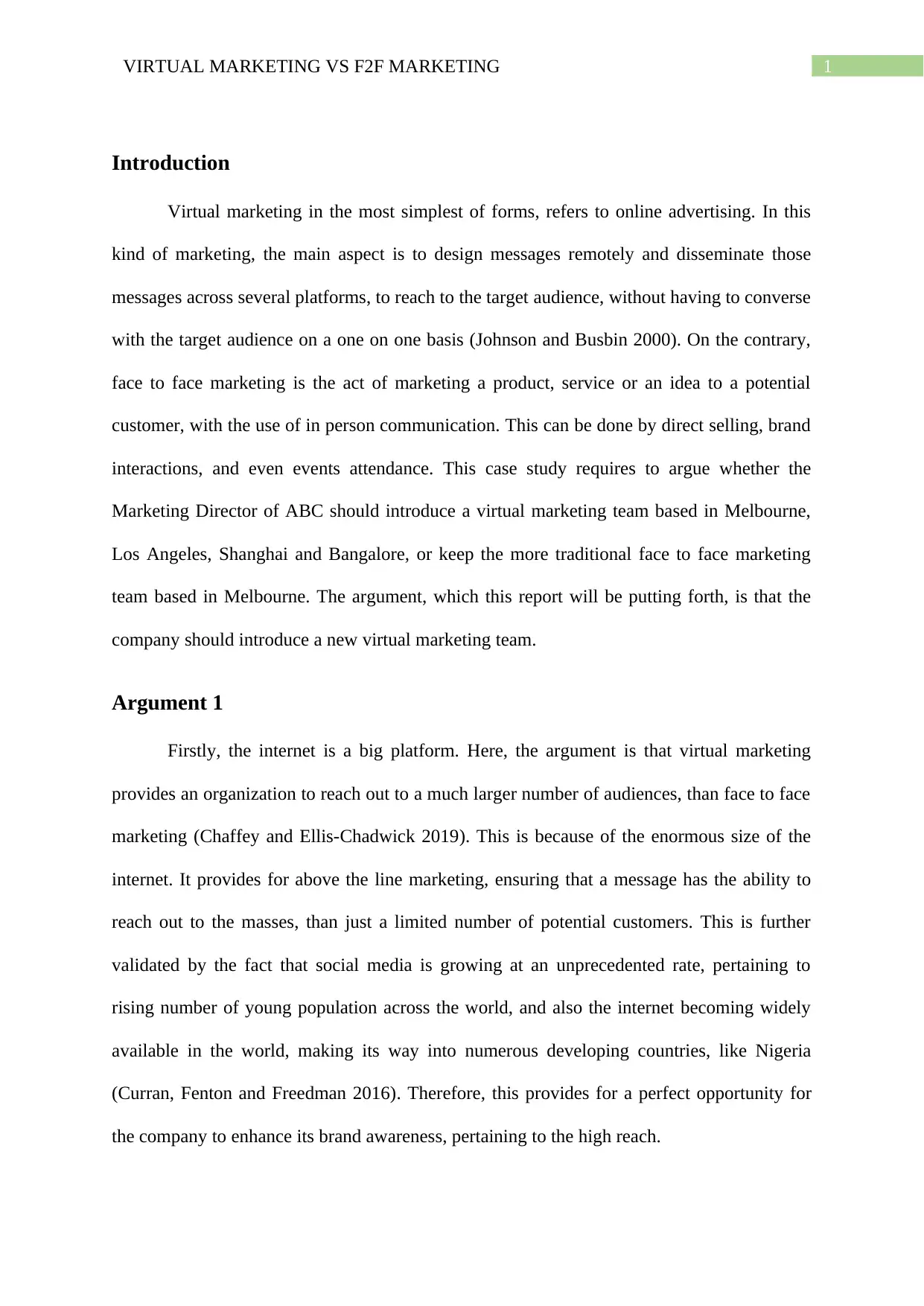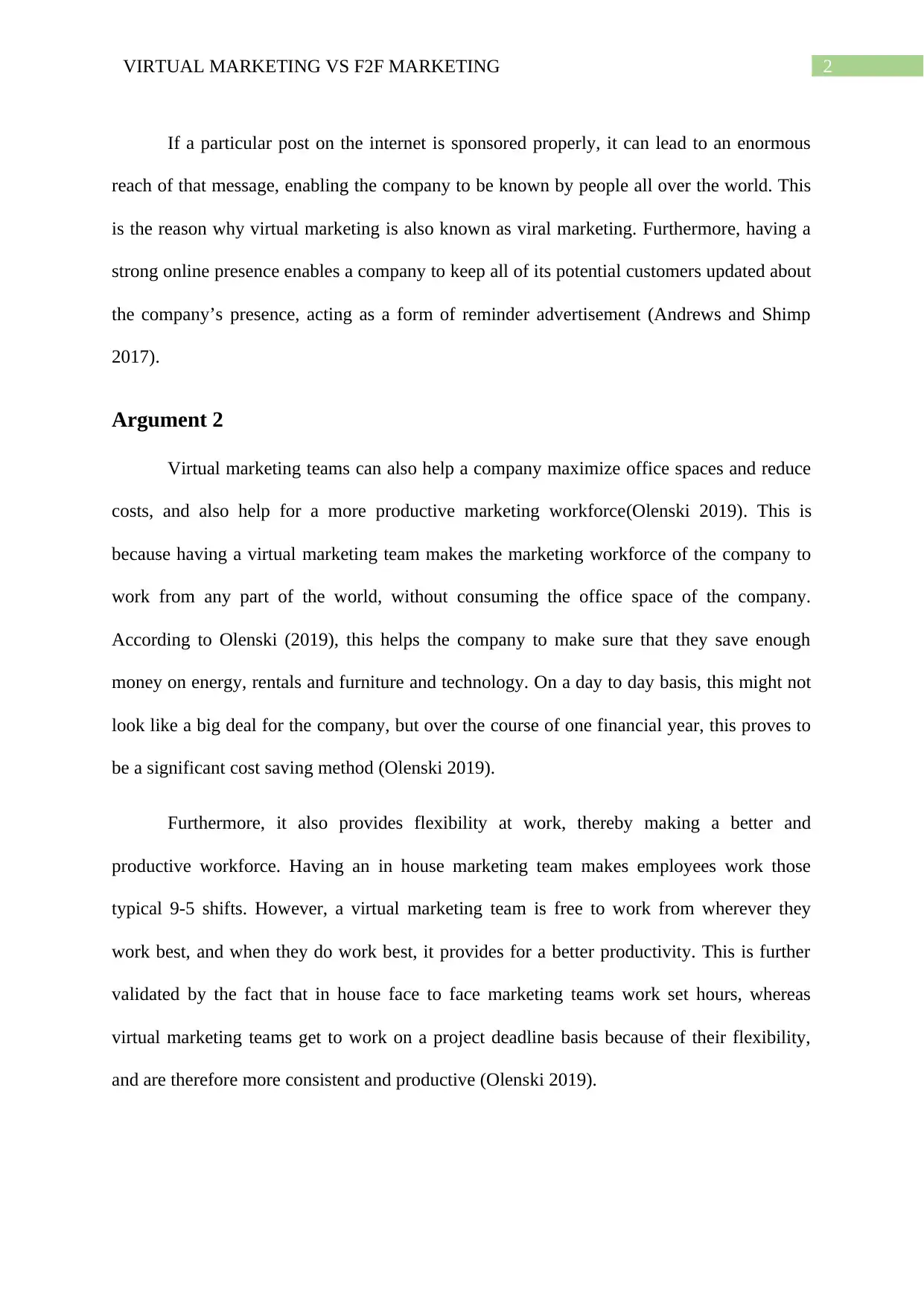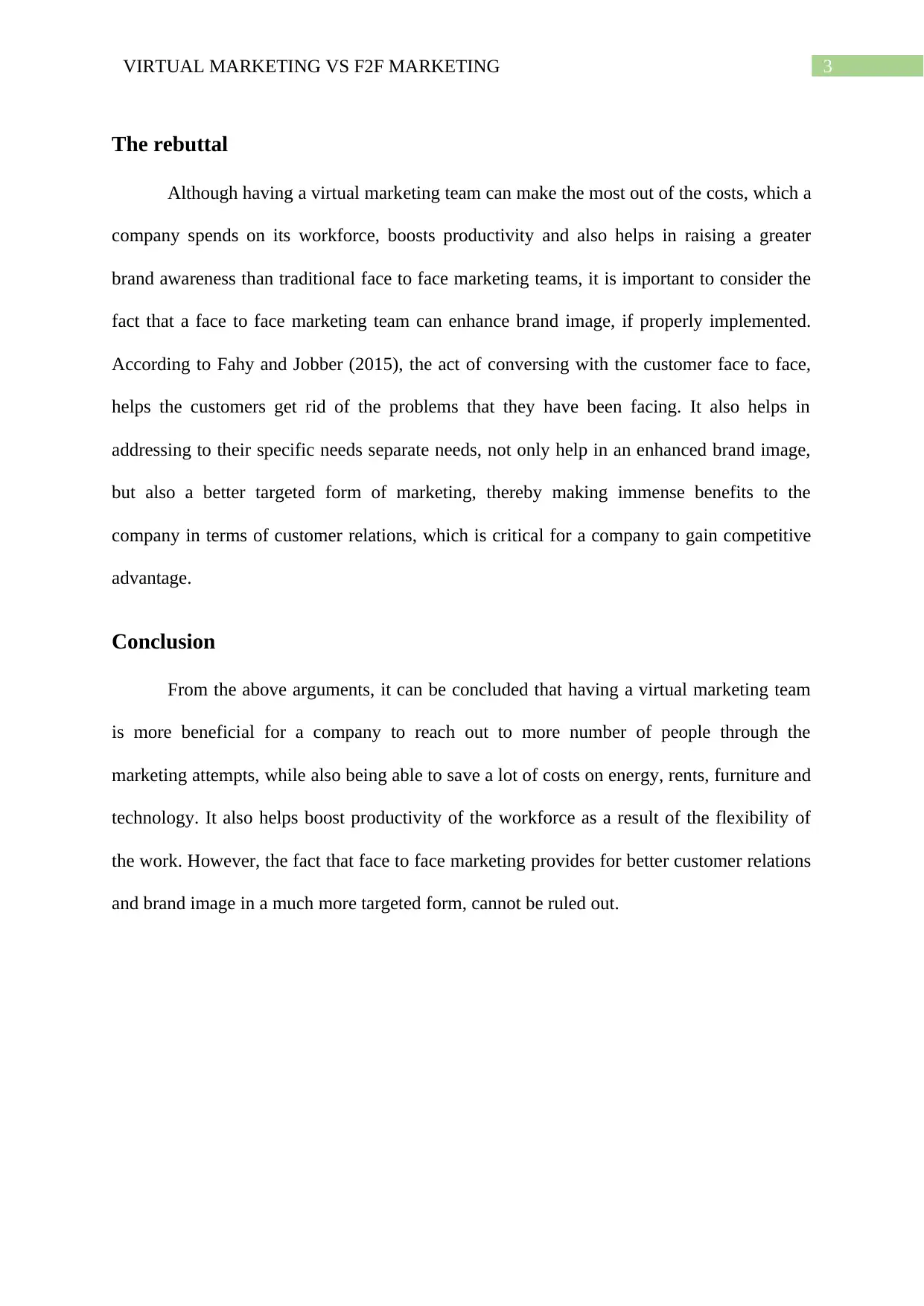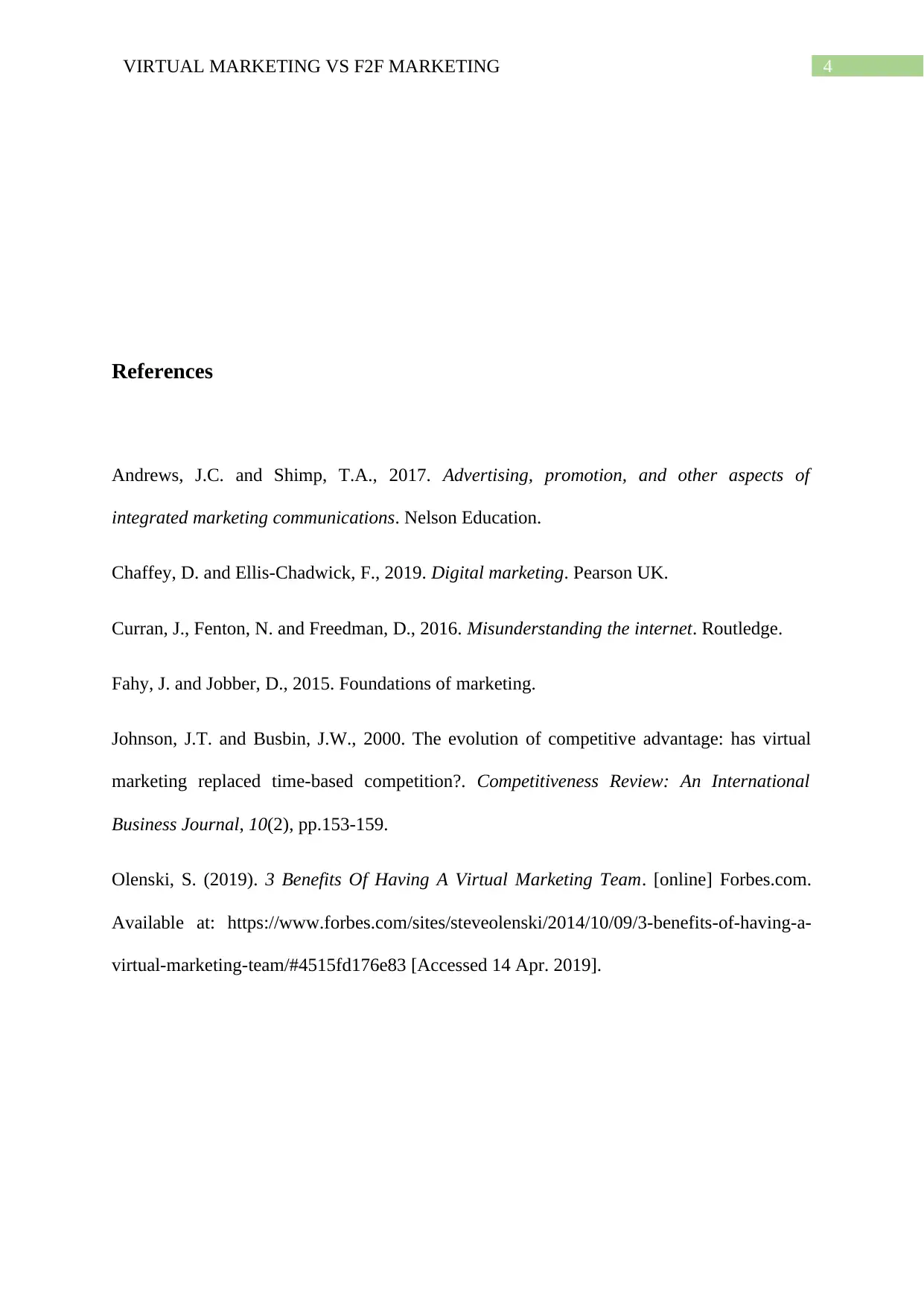MNG81001 Report: Virtual Marketing Team Recommendation for ABC Company
VerifiedAdded on 2023/01/19
|5
|1139
|67
Report
AI Summary
This report analyzes the effectiveness of virtual marketing versus face-to-face (F2F) marketing strategies for ABC Company, in response to the Marketing Director's decision on whether to introduce a virtual marketing team. The report argues in favor of a virtual marketing team, emphasizing the internet's broad reach, which allows for greater brand awareness, and the potential cost savings and increased productivity associated with remote teams. The report supports this argument with evidence and data, while also acknowledging that F2F marketing can enhance brand image and improve customer relations. Ultimately, the report concludes that virtual marketing offers greater benefits, recommending that ABC Company adopt a virtual marketing team to reach a wider audience and improve operational efficiency, while acknowledging the importance of customer relations.

Running head: VIRTUAL MARKETING VS F2F MARKETING
VIRTUAL MARKETING VS F2F MARKETING
Name of the Student:
Name of the University:
Author Note:
VIRTUAL MARKETING VS F2F MARKETING
Name of the Student:
Name of the University:
Author Note:
Paraphrase This Document
Need a fresh take? Get an instant paraphrase of this document with our AI Paraphraser

1VIRTUAL MARKETING VS F2F MARKETING
Introduction
Virtual marketing in the most simplest of forms, refers to online advertising. In this
kind of marketing, the main aspect is to design messages remotely and disseminate those
messages across several platforms, to reach to the target audience, without having to converse
with the target audience on a one on one basis (Johnson and Busbin 2000). On the contrary,
face to face marketing is the act of marketing a product, service or an idea to a potential
customer, with the use of in person communication. This can be done by direct selling, brand
interactions, and even events attendance. This case study requires to argue whether the
Marketing Director of ABC should introduce a virtual marketing team based in Melbourne,
Los Angeles, Shanghai and Bangalore, or keep the more traditional face to face marketing
team based in Melbourne. The argument, which this report will be putting forth, is that the
company should introduce a new virtual marketing team.
Argument 1
Firstly, the internet is a big platform. Here, the argument is that virtual marketing
provides an organization to reach out to a much larger number of audiences, than face to face
marketing (Chaffey and Ellis-Chadwick 2019). This is because of the enormous size of the
internet. It provides for above the line marketing, ensuring that a message has the ability to
reach out to the masses, than just a limited number of potential customers. This is further
validated by the fact that social media is growing at an unprecedented rate, pertaining to
rising number of young population across the world, and also the internet becoming widely
available in the world, making its way into numerous developing countries, like Nigeria
(Curran, Fenton and Freedman 2016). Therefore, this provides for a perfect opportunity for
the company to enhance its brand awareness, pertaining to the high reach.
Introduction
Virtual marketing in the most simplest of forms, refers to online advertising. In this
kind of marketing, the main aspect is to design messages remotely and disseminate those
messages across several platforms, to reach to the target audience, without having to converse
with the target audience on a one on one basis (Johnson and Busbin 2000). On the contrary,
face to face marketing is the act of marketing a product, service or an idea to a potential
customer, with the use of in person communication. This can be done by direct selling, brand
interactions, and even events attendance. This case study requires to argue whether the
Marketing Director of ABC should introduce a virtual marketing team based in Melbourne,
Los Angeles, Shanghai and Bangalore, or keep the more traditional face to face marketing
team based in Melbourne. The argument, which this report will be putting forth, is that the
company should introduce a new virtual marketing team.
Argument 1
Firstly, the internet is a big platform. Here, the argument is that virtual marketing
provides an organization to reach out to a much larger number of audiences, than face to face
marketing (Chaffey and Ellis-Chadwick 2019). This is because of the enormous size of the
internet. It provides for above the line marketing, ensuring that a message has the ability to
reach out to the masses, than just a limited number of potential customers. This is further
validated by the fact that social media is growing at an unprecedented rate, pertaining to
rising number of young population across the world, and also the internet becoming widely
available in the world, making its way into numerous developing countries, like Nigeria
(Curran, Fenton and Freedman 2016). Therefore, this provides for a perfect opportunity for
the company to enhance its brand awareness, pertaining to the high reach.

2VIRTUAL MARKETING VS F2F MARKETING
If a particular post on the internet is sponsored properly, it can lead to an enormous
reach of that message, enabling the company to be known by people all over the world. This
is the reason why virtual marketing is also known as viral marketing. Furthermore, having a
strong online presence enables a company to keep all of its potential customers updated about
the company’s presence, acting as a form of reminder advertisement (Andrews and Shimp
2017).
Argument 2
Virtual marketing teams can also help a company maximize office spaces and reduce
costs, and also help for a more productive marketing workforce(Olenski 2019). This is
because having a virtual marketing team makes the marketing workforce of the company to
work from any part of the world, without consuming the office space of the company.
According to Olenski (2019), this helps the company to make sure that they save enough
money on energy, rentals and furniture and technology. On a day to day basis, this might not
look like a big deal for the company, but over the course of one financial year, this proves to
be a significant cost saving method (Olenski 2019).
Furthermore, it also provides flexibility at work, thereby making a better and
productive workforce. Having an in house marketing team makes employees work those
typical 9-5 shifts. However, a virtual marketing team is free to work from wherever they
work best, and when they do work best, it provides for a better productivity. This is further
validated by the fact that in house face to face marketing teams work set hours, whereas
virtual marketing teams get to work on a project deadline basis because of their flexibility,
and are therefore more consistent and productive (Olenski 2019).
If a particular post on the internet is sponsored properly, it can lead to an enormous
reach of that message, enabling the company to be known by people all over the world. This
is the reason why virtual marketing is also known as viral marketing. Furthermore, having a
strong online presence enables a company to keep all of its potential customers updated about
the company’s presence, acting as a form of reminder advertisement (Andrews and Shimp
2017).
Argument 2
Virtual marketing teams can also help a company maximize office spaces and reduce
costs, and also help for a more productive marketing workforce(Olenski 2019). This is
because having a virtual marketing team makes the marketing workforce of the company to
work from any part of the world, without consuming the office space of the company.
According to Olenski (2019), this helps the company to make sure that they save enough
money on energy, rentals and furniture and technology. On a day to day basis, this might not
look like a big deal for the company, but over the course of one financial year, this proves to
be a significant cost saving method (Olenski 2019).
Furthermore, it also provides flexibility at work, thereby making a better and
productive workforce. Having an in house marketing team makes employees work those
typical 9-5 shifts. However, a virtual marketing team is free to work from wherever they
work best, and when they do work best, it provides for a better productivity. This is further
validated by the fact that in house face to face marketing teams work set hours, whereas
virtual marketing teams get to work on a project deadline basis because of their flexibility,
and are therefore more consistent and productive (Olenski 2019).
⊘ This is a preview!⊘
Do you want full access?
Subscribe today to unlock all pages.

Trusted by 1+ million students worldwide

3VIRTUAL MARKETING VS F2F MARKETING
The rebuttal
Although having a virtual marketing team can make the most out of the costs, which a
company spends on its workforce, boosts productivity and also helps in raising a greater
brand awareness than traditional face to face marketing teams, it is important to consider the
fact that a face to face marketing team can enhance brand image, if properly implemented.
According to Fahy and Jobber (2015), the act of conversing with the customer face to face,
helps the customers get rid of the problems that they have been facing. It also helps in
addressing to their specific needs separate needs, not only help in an enhanced brand image,
but also a better targeted form of marketing, thereby making immense benefits to the
company in terms of customer relations, which is critical for a company to gain competitive
advantage.
Conclusion
From the above arguments, it can be concluded that having a virtual marketing team
is more beneficial for a company to reach out to more number of people through the
marketing attempts, while also being able to save a lot of costs on energy, rents, furniture and
technology. It also helps boost productivity of the workforce as a result of the flexibility of
the work. However, the fact that face to face marketing provides for better customer relations
and brand image in a much more targeted form, cannot be ruled out.
The rebuttal
Although having a virtual marketing team can make the most out of the costs, which a
company spends on its workforce, boosts productivity and also helps in raising a greater
brand awareness than traditional face to face marketing teams, it is important to consider the
fact that a face to face marketing team can enhance brand image, if properly implemented.
According to Fahy and Jobber (2015), the act of conversing with the customer face to face,
helps the customers get rid of the problems that they have been facing. It also helps in
addressing to their specific needs separate needs, not only help in an enhanced brand image,
but also a better targeted form of marketing, thereby making immense benefits to the
company in terms of customer relations, which is critical for a company to gain competitive
advantage.
Conclusion
From the above arguments, it can be concluded that having a virtual marketing team
is more beneficial for a company to reach out to more number of people through the
marketing attempts, while also being able to save a lot of costs on energy, rents, furniture and
technology. It also helps boost productivity of the workforce as a result of the flexibility of
the work. However, the fact that face to face marketing provides for better customer relations
and brand image in a much more targeted form, cannot be ruled out.
Paraphrase This Document
Need a fresh take? Get an instant paraphrase of this document with our AI Paraphraser

4VIRTUAL MARKETING VS F2F MARKETING
References
Andrews, J.C. and Shimp, T.A., 2017. Advertising, promotion, and other aspects of
integrated marketing communications. Nelson Education.
Chaffey, D. and Ellis-Chadwick, F., 2019. Digital marketing. Pearson UK.
Curran, J., Fenton, N. and Freedman, D., 2016. Misunderstanding the internet. Routledge.
Fahy, J. and Jobber, D., 2015. Foundations of marketing.
Johnson, J.T. and Busbin, J.W., 2000. The evolution of competitive advantage: has virtual
marketing replaced time-based competition?. Competitiveness Review: An International
Business Journal, 10(2), pp.153-159.
Olenski, S. (2019). 3 Benefits Of Having A Virtual Marketing Team. [online] Forbes.com.
Available at: https://www.forbes.com/sites/steveolenski/2014/10/09/3-benefits-of-having-a-
virtual-marketing-team/#4515fd176e83 [Accessed 14 Apr. 2019].
References
Andrews, J.C. and Shimp, T.A., 2017. Advertising, promotion, and other aspects of
integrated marketing communications. Nelson Education.
Chaffey, D. and Ellis-Chadwick, F., 2019. Digital marketing. Pearson UK.
Curran, J., Fenton, N. and Freedman, D., 2016. Misunderstanding the internet. Routledge.
Fahy, J. and Jobber, D., 2015. Foundations of marketing.
Johnson, J.T. and Busbin, J.W., 2000. The evolution of competitive advantage: has virtual
marketing replaced time-based competition?. Competitiveness Review: An International
Business Journal, 10(2), pp.153-159.
Olenski, S. (2019). 3 Benefits Of Having A Virtual Marketing Team. [online] Forbes.com.
Available at: https://www.forbes.com/sites/steveolenski/2014/10/09/3-benefits-of-having-a-
virtual-marketing-team/#4515fd176e83 [Accessed 14 Apr. 2019].
1 out of 5
Related Documents
Your All-in-One AI-Powered Toolkit for Academic Success.
+13062052269
info@desklib.com
Available 24*7 on WhatsApp / Email
![[object Object]](/_next/static/media/star-bottom.7253800d.svg)
Unlock your academic potential
Copyright © 2020–2025 A2Z Services. All Rights Reserved. Developed and managed by ZUCOL.



